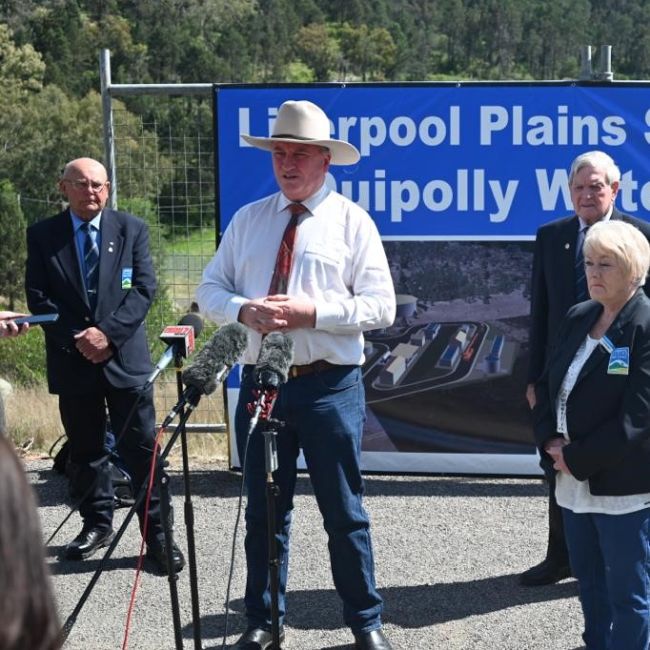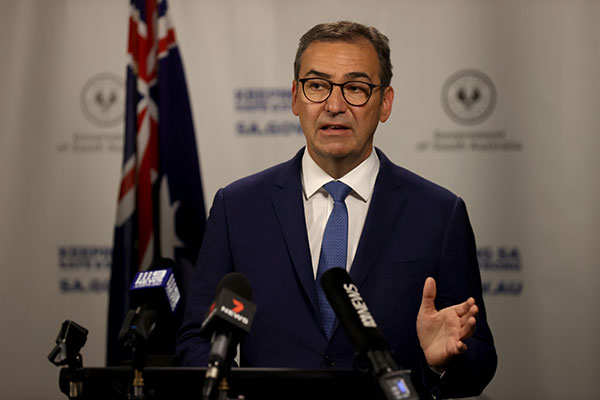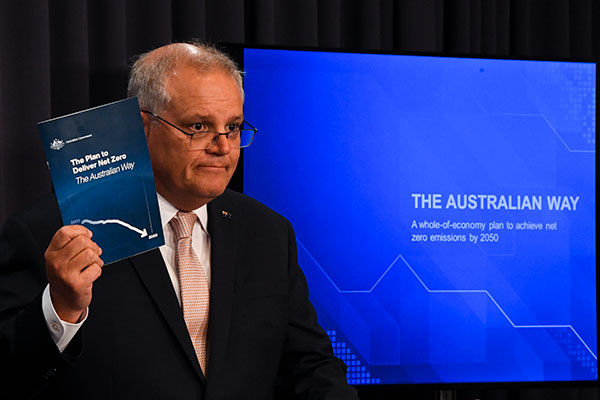Selected
- Details
- Written by Grant Broadcasters
- Category: Selected
- Hits: 114

Acting Prime Minister Barnaby Joyce and Australian tech billionaire Mike Cannon-Brookes have clashed over the government's net zero emissions plan.
In an often tense exchange at The Daily Telegraph's virtual bush summit, the tech boss repeatedly asked the Nationals leader how the government was going to reach its emissions targets.
The co-founder and CEO of software company Atlassian said while "there are things in the pamphlet that I agree with", the details haven't been explained and he doesn't understand "the how".
The billionaire this week tweeted that the 129 page plan was "ridiculously embarrassing".
The modelling is due to be released in the next few weeks.
Mr Cannon-Brookes said the idea that methane challenges would destroy the beef industry, as outlined by the Nationals leader earlier in the week, was "bulls***".
"How are we going to get methane down to zero? Is it going to come at the expense of the gas industry or ag? Where is it going to come from?" asked Mr Cannon-Brookes.
The tech boss shook his head while the Nationals leader argued that renewables were unreliable and more costly.
"To say that wind makes power cheaper... We've had a six fold increase in power prices in a year... because wind power is unable to fill the void," Mr Joyce said, adding it was a "BS argument" that power prices and reliability aren't affected.
But Mr Cannon-Brookes said "blaming renewables... is the same old tired argument".
They had contributed to a seven per cent drop in NSW power prices, he said.
The two men also clashed over whether renewables would help underpin regional towns in Australia.
"I can't think of one renewable town in Australia, not one, so all these hundreds of thousands of jobs .. surely there would be some of these 'renewable' towns popping up. But they don't exist because it's a mythical statement," Mr Joyce said.
The billionaire hit back.
"I can't tell you where there's a renewable town in Australia because it's all of them," he said.
"Australia's future is underpinned by renewables in a decarbonised economy, in every region in every town."
Mr Joyce wrapped up the session saying the government had to be honest with regional workers and that "right now we are exporting more coal at a higher price than ever before, and that's the truth".
But it was left to Mr Cannon-Brookes to have the last word, and he criticised the government's emissions plan for its lack of detail and ambition.
"We need a plan we don't have one," he said.
© AAP 2021
Image: Barnaby Joyce MP Facebook
- Details
- Written by Grant Broadcasters
- Category: Selected
- Hits: 138

Aged care residents are expected to be the first people to receive a coronavirus vaccine booster shot after the medical regulator gave the green light.
The Therapeutic Goods Administration on Wednesday gave provisional approval for Australians 18 and over to receive a top-up dose of the Pfizer vaccine.
Prime Minister Scott Morrison said the government would finalise plans for the expanded rollout within the next week.
"We'll be starting with those in the aged care facilities like we did with the vaccine program," he told the Nine Network.
People with severely compromised immune systems are already eligible for a third jab but the latest advice paves the way for the general population to receive another shot.
The TGA recommended the booster shot be given at least six months after a person's second dose.
The Australian Technical Advisory Group on Immunisation will provide further advice on boosters to the government shortly.
Leading epidemiologist Mary-Louise McLaws said third shots were proven to work well.
"There's fantastic evidence now that your booster shot really does supercharge your immune system to get that vaccine efficacy up high," she told the Nine Network.
'There are many people who will benefit from this."
© AAP 2021
- Details
- Written by Grant Broadcasters
- Category: Selected
- Hits: 135

South Australia will remove all domestic border restrictions from November 23 for travellers who are fully vaccinated against COVID-19.
Quarantine periods for overseas arrivals will be reduced from 14 days to seven from the same date, while the cap on home gatherings will rise from 20 people to 30.
Other internal restrictions are expected to be eased before Christmas as SA eyes a return to relative normality for the festive season.
"There has to be some reward for the sacrifices that individuals and businesses have made, and today it is with great pride I announce our COVID-ready plan for South Australia," Premier Steven Marshall told reporters on Tuesday.
"I know this will be a huge relief for so many South Australians who are wanting to get back to normality as soon as possible."
Authorities are expecting 80 per cent of South Australian adults to be fully vaccinated by November 23.
Further restrictions will be eased once 90 per cent of the population aged 12 and over has been double-jabbed.
That is expected to be achieved before Christmas, allowing quarantine to be scrapped for fully vaccinated overseas arrivals.
There will be no requirement for all individual local government areas to achieve the 80 per cent rate by November 23, but Mr Marshall said authorities would redouble their vaccination efforts in areas that were lagging.
"I think there will be a big surge now in the vaccination rate," he said.
"The health experts are now telling us that vaccination is our pathway out."
Anyone who becomes infected between the 80 per cent and 90 per cent thresholds will still need to isolate, along with their close contacts.
© AAP 2021
Photo: South Australian Premier Steven Marshall (AAP Image/Kelly Barnes)
SA's COVID-Ready Plan safely eases restrictions over the coming months and coordinates the health response to manage COVID-19.
— SA Health (@SAHealth) October 26, 2021
It's important to continue to get tested for COVID-19 if you have any symptoms, physical distance, wash your hands, and stay home if you are sick. pic.twitter.com/khu0Tbvfkr
- Details
- Written by Grant Broadcasters
- Category: Selected
- Hits: 111

Australia's 2050 net-zero carbon emissions target will rely on existing technologies to meet 85 per cent of the goal with the remainder to be achieved through new breakthroughs.
Prime Minister Scott Morrison on Tuesday confirmed he would take the commitment to the United Nations climate conference which starts on Sunday in Glasgow.
Australia's carbon emissions have fallen 20 per cent since 2005.
The plan to achieve the remaining 80 per cent in the next three decades relies on the government's technology investment roadmap reducing emissions by 40 per cent.
Global technology trends are expected to account for 15 per cent, while international and domestic offsets represent a 10 to 20 per cent reduction.
The remaining 15 per cent is expected to be achieved through further technology breakthroughs.
Mr Morrison said there would be no legislation or mandates attached to the target.
"It will not increase energy bills. It is not a revolution but a careful evolution to take advantage of changes in our markets," he told reporters in Canberra.
The Productivity Commission will every five years from 2023 monitor the socio-economic impact of climate action on regional communities.
The government has committed to spending $20 billion on low emissions technologies by 2030.
That is expected to trigger between $60 billion and $100 billion of public-private investments over the same period.
According to the plan, Australians will be almost $2000 between off on average in 2050, while 62,000 new regional mining and heavy industry jobs are mooted.
UK Prime Minister Boris Johnson hailed the commitment as heroic because of Australia's heavy reliance on coal and other emissions-heavy industries.
But the COP26 summit his government is chairing is expected to focus on more ambitious 2030 targets from nations ramping up climate action.
Australia has ruled out boosting end-of-decade targets, instead relying on projections it will exceed a 26 to 28 per cent reduction by 2030.
The government's latest data predicts emissions will be cut by 30 to 35 per cent on 2005 levels by 2030.
"We may even achieve better, but this is the approach we put to the Australian people," Mr Morrison said.
Resources Minister Keith Pitt has been elevated to cabinet, giving the Nationals a fifth seat at the table, in return for the junior coalition partner's support for the plan.
Opposition Leader Anthony Albanese seized on reports Deputy Prime Minister Barnaby Joyce and fellow Nationals cabinet ministers Bridget McKenzie and Mr Pitt opposed the goal in the party room.
Mr Albanese described the government as a shambles.
"They are committing the fatal mistake of wanting to provide two contradictory messages to different parts of the country," he told a caucus meeting in Canberra.
Some Nationals backbenchers including outspoken Queensland senator Matt Canavan have vowed to continue campaigning against the policy.
There is internal concern the coalition could bleed votes to conservative outfits including Pauline Hanson's One Nation and Clive Palmer's United Australia Party.
© AAP 2021
Photo: Australian Prime Minister Scott Morrison (AAP Image/Lukas Coch)
Page 130 of 191